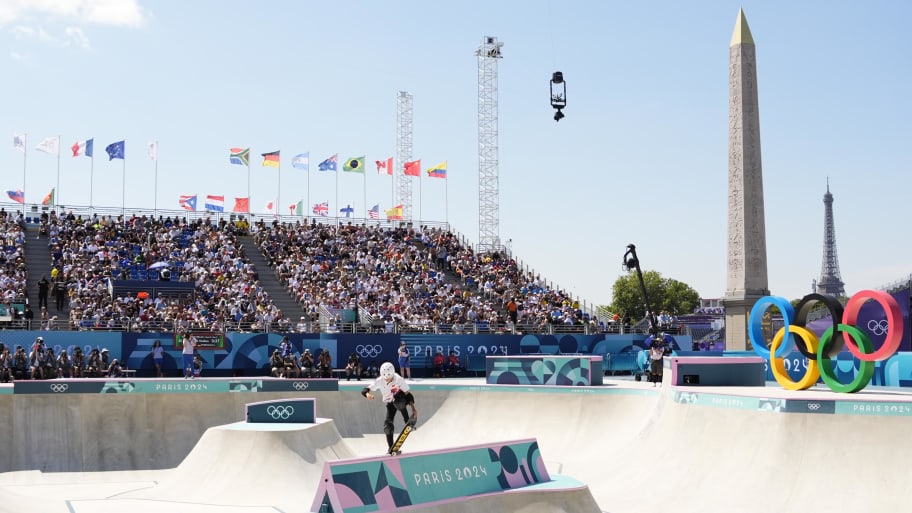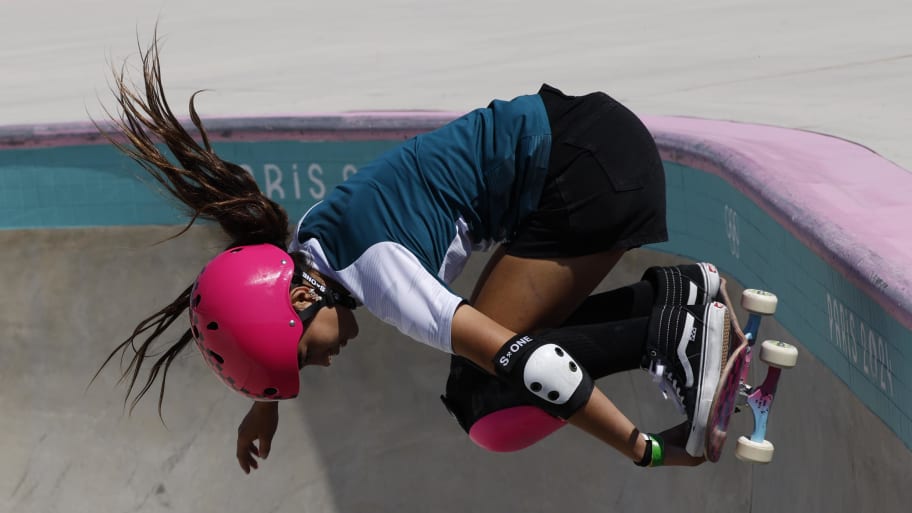
PARIS — Inside the skateboard park at Place de la Concorde on Tuesday, fans braved blistering temperatures and no small amount of body odor poisoning the air around them. Why? Easy. They were watching the best women’s skateboarders in the world ply their trade in an Olympic final, inside a venue stuffed to the brim with people, colors, beats and food. Many could see the Luxor Obelisk—the gold-brimmed, ancient Egyptian centerpiece in the Place de la Concorde—from their seats, sometimes with skateboarders soaring into view in front of it. Others could spy the Eiffel Tower; still others, if they craned their necks, could behold the Arc de Triomphe, far off in the distance, or the Grand Palais.
Still, as the final unfolded round by round on Tuesday evening, fewer heads looked yonder and most every head looked down. Park skateboarding ranks among the most visceral of Olympic sports. There are 540-degree spins— think: one full spin and another half, while flying through the air and, ideally, landing on a skateboard. There are body varials that incorporate those spins, boards rotating along with bodies. There are, in the sport’s parlance, shreds and hips, along with flips, handplants, spins and grinds. It’s part art; it’s all athleticism.
The discipline doesn’t need a setting that drops jaws. But it has one, anyway.
The park itself resembled a moon crater, dropped into the middle of Paris proper. And, as these Paris Games unfolded and concerns over everything from security to its city-centered nature faded far from view, skateboarding became something of a centerpiece. This place exuded joy. So did the competitions.
Andy Macdonald, the veteran British competitor—and by veteran, we mean, he’s 51—described the difference, for skateboarding specifically, from Tokyo to Paris. Beyond the obvious (no fans, now fans), he said that, in Tokyo, when skateboarding made its Olympic debut, most athletes were “a little gun-shy” about how officials and television networks would present their sport—and how that presentation would be perceived. But on the day of the men’s street finals last week, Macdonald saw what everyone here saw: “One of the best finals ever.”
He also gave one anecdote that highlighted the sport’s popularity in Paris. Tony Hawk, the most iconic figure in skateboarding’s not-so-short history, couldn’t get enough tickets to bring his entire family to an event he was attending.
On Tuesday, that combination of venue, elite athletes and the women’s park final followed the same formula, enhancing skateboarding’s place in the Olympics. Specifically, these Olympics.
Consider Sky Brown, for example: Born in Japan to a Japanese mother and British father, she began skateboarding and surfing at age 3. She went viral for the first time a year later, after her father posted a video of her shredding—concrete, not waves—on social media. She was the youngest-ever Vans U.S. Open of Surfing participant, in 2016 at age 8. She was the only girl on her school’s soccer team at 10. She turned pro in skateboarding one year after that—and soon became the first female competitor, ever, at any age, to land a frontside 540. She was 11.
Soon, she won Dancing with the Stars: Juniors and landed a Nike sponsorship in 2018. She survived a 15-foot fall, soaring up a halfpipe only to plummet back toward concrete. That landing, still brutal to even watch, fractured her skull and left arm, while lacerating her heart and lungs. A helicopter flew Brown to the hospital, as she went in and out of consciousness, then straight into the ICU. The Tokyo Games were only a few months away. She recovered enough to compete in them, gifted additional time from the delay caused by the global pandemic, and won a bronze medal in park skateboarding to boot. This made her both Great Britain’s youngest-ever summer Olympian and youngest medal winner. She was 13.
Brown is 16 now. She doesn’t have a coach. She doesn’t need one. She became the first female skateboarder to complete a 540 and then a 720 at the X Games. She currently splits the year in half, living in her hometown and in the U.S. She trains with Shaun White, teaches English pop stars to skateboard, and yet, ranks Mean Girls among her favorite movies. She arrived in Paris after another round of injuries to recover from (MCL tear, dislocated shoulder). She packed an Olympic backstory into her luggage, and she arrived here among the favorites.
That’s just one story, of one competitor, nine lives lived in 16 short years. Brown wanted to compete in Paris, because she saw her sport evolving—each routine more technical and advanced, the competition stiffer than the boards underneath the athletes’ feet—and she wanted to be a part of that push. After one practice early into the Games, she was struck by how loud the crowd screamed. Brown went opposite Allen Iverson in her description. She was talking about practice; here, as a spectacular spectacle that gifted competitors energy and drive. “It’s going to be sick,” she said.
Just as Australia’s Arisa Trew described the venue heading into the competition. Only 14 herself, and, like Brown, a surf-skate dual-sport athlete, Trew almost qualified to Tokyo but didn’t quite make the Aussie team. She came to Paris determined to make up for not being an Olympian … then age 11. She described the vibe the same as Brown had. Sick. She also revealed that she loved glancing at the Eiffel Tower while mid-air in practice runs. Also sick.
And, yes, they were right. Sick, it was.

The preliminary round Tuesday whittled the field from 22 competitors to eight. Judges considered the difficulty in the competitors' chosen tricks, along with their style, their flow and their use of available terrain. Each run lasts for 45 seconds. Most presented the sport’s duality—pure, remarkable athleticism balanced by the poetry of choice. What Brown later called “the beautifulness of skateboarding,” more or less.
The final featured two medalists from Tokyo—Brown and Cocona Hiraki, the silver medalist in the discipline’s debut. All faced stiffer competition than three years ago with Trew, Naia Laso (Spain), Dora Varella (Brazil), Bryce Wettstein (U.S.) and a deep field.
When the final kicked off in the early evening, general consensus had already formed. Scores around 90 or above were likely necessary to approach medaling. Anyone who wanted to medal probably had to break that mark.
There were miscues early, perhaps owing to the stage and its inherent stakes. Laso lost control of the board underfoot toward the end of her first run. Trew started hers to oohs and aahs, but … same. Hinano Kusaki (Japan) false-started. All the mistakes, when combined, allowed room for other competitors to surge up the leaderboard. Wettstein, the American, went first; her run was captivating, good for an 88.12. She held the lead then—but not for long. Hiraki took it back, scoring 91.98, as the first round of runs concluded.
Up, up, up the scores inched as skateboarders soared skyward—one toward five colorful rings (on the near horizon) and the obelisk (on a more distant one). One did a backward flip afterward, using her board as a launch point, then launching with both hands.
Hiraki still led after the second round of final runs. Laso, one of the favorites before a back injury, continued to compete valiantly despite the injury. She hadn’t broken 60 after two attempts cruising through the park.
Trew, though, began to stand apart. She broke 90 in her second time down, then upped that in her third run. She sort of resembled a ballet dancer, on a skateboard, by her favorite landmark, the Eiffel. What a sentence. She smiled a lot. She dazzled even more. Brown would later admit that her injured shoulder hurt throughout the competition, and it hurt worse after she crash-landed on it.
She gutted out a 92.31 score in her third run, which was good enough for bronze. In that same final round, Hiraki matched her Tokyo performance, upping her score (92.63) and sliding into second for the silver.
Which left Trew, the 14-year-old Aussie, all smiles and soars, equal parts adorable and fierce. Make no mistake, she’s an athlete, a competitor and a force. She’s also a teenager, and that’s meant with zero disrespect. In fact, it was refreshing to watch her afterward, gold medal secured but face absent either pressure or relief. Those who want to wring their hands about the age of skateboarders should also view this most healthy of approaches. Olympic final. Sick course. Killer run. Gold medal.
And then: “I’m just going to keep skating and pushing myself and having fun with my friends,” Trew said.
She sounded sincere, and that, right there, was the wild part. Because Trew and the women sitting next to her or skateboarding here in Paris are changing not just how Parisians view this X Games event-turned-Olympic sport. They’re changing how it’s competed, which will change how the whole world looks at them—and soon.
This article was originally published on www.si.com as In Women’s Olympic Skateboarding, the Beauty of Paris Meets a Sport on the Rise.







